Savory French Toast with Parmesan, Lemon & Fresh Herbs: Your Ultimate Brunch Game-Changer
Are you tired of the same old syrup-drenched breakfasts that often leave you in a sugar coma before noon? It’s time to revolutionize your brunch routine with this incredible Savory French Toast with Parmesan, Lemon, and Fresh Herbs. Forget everything you thought you knew about French toast; this isn’t your grandma’s sweet treat. This is French toast’s cooler, more sophisticated cousin – crispy on the outside, wonderfully creamy on the inside, and bursting with vibrant, zesty, and aromatic herby flavor. It’s an unforgettable experience that proves savory can be just as satisfying, if not more so, for your morning (or afternoon) meal.
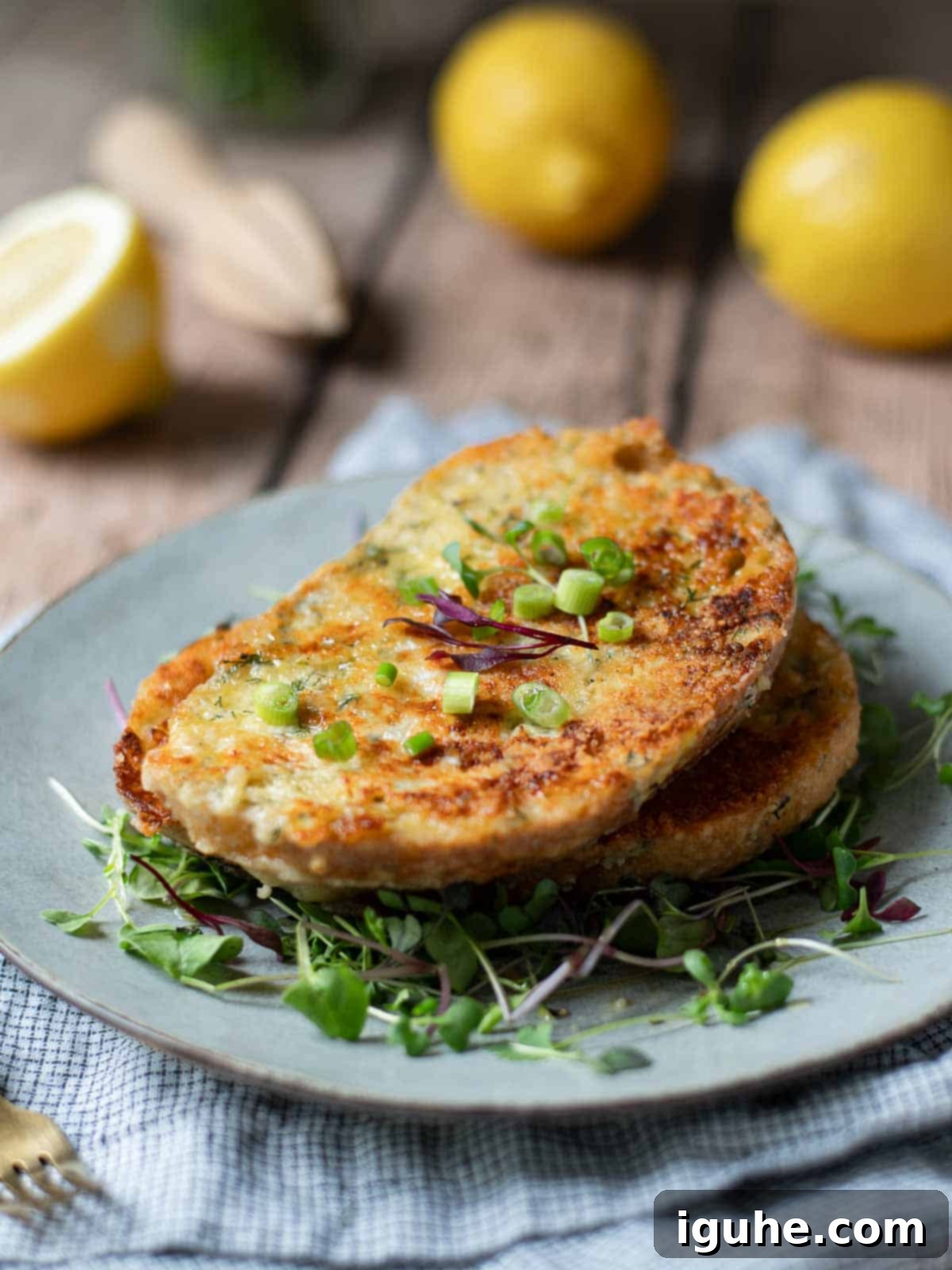
This savory French toast, known in France as pain perdu (lost bread), is so delicious that you might just forget about sweet versions entirely. Okay, that’s a slight exaggeration – I definitely still cherish a good sweet French toast! But there’s something truly special and deeply satisfying about a savory rendition. Plus, anything that allows me to add a perfectly cooked, drippy egg on top is an instant win in my culinary book. This recipe transforms humble bread into a gourmet experience.
Instead of the typical sugary custard that forms the base of traditional French toast, we’re embarking on a flavor journey with light yet incredibly comforting savory notes. We’ll infuse our egg mixture with salty Parmesan cheese, the bright zest of fresh lemon, and a medley of fragrant herbs. This combination creates a rich, complex soaking liquid that thoroughly penetrates each hearty slice of bread, promising a flavorful bite every time.
Whether you’re hosting a lavish brunch, seeking a hearty breakfast, or craving a unique lunch, this Parmesan, Lemon, and Herb Savory French Toast delivers. It’s a versatile dish that’s surprisingly easy to make, yet impressive enough to wow any guest. Prepare to experience French toast in a whole new, delicious dimension!
[feast_advanced_jump_to]
What You Will Need: Key Ingredients for Savory French Toast
Crafting the perfect savory French toast starts with a selection of readily available ingredients, many of which you likely already have in your pantry or refrigerator. This recipe is designed to be flexible, allowing for easy substitutions to fit your preferences or what you have on hand. Let’s explore the essential components:

- Eggs: These form the creamy, binding custard base that gives French toast its signature texture. Fresh, large eggs are always recommended for the best results.
- Half & Half (or Milk/Cream): A blend of heavy cream and milk offers the perfect richness and velvety texture to the custard. However, feel free to use all milk for a lighter option, all cream for extra indulgence, or your favorite unsweetened plant-based milk for a dairy-free alternative. Just be sure to avoid any sugary milk substitutes, as we’re focusing on savory flavors here.
- Lemon: Both freshly squeezed lemon juice and its vibrant zest are crucial. They provide a bright, zesty zing that beautifully cuts through the richness of the cheese and eggs, adding a refreshing note. Always opt for fresh lemons for maximum flavor impact.
- Dijon Mustard: This secret ingredient adds a subtle yet essential sharp kick and depth of flavor to the custard, complementing the other savory elements without overpowering them. Don’t skip it!
- Garlic: Minced garlic introduces a deeper, aromatic savory dimension. Use fresh garlic for the most potent and delicious flavor.
- Grated Cheese: Finely grated Parmesan or Pecorino Romano cheese is key for that irresistible salty, umami flavor and crispy crust when pan-fried. Ensure it’s good quality cheese for the best taste.
- Fresh Herbs: This is where the “herb” magic happens! Dill, parsley, tarragon, chives, or even a touch of thyme are all fantastic choices. Use any combination you love. Fresh herbs provide an aromatic burst that elevates the entire dish.
- Salt and Pepper: Essential for seasoning and balancing all the robust flavors. Kosher salt and freshly ground black pepper are preferred for their superior taste.
- Butter: Plenty of unsalted butter is needed for frying the bread to a beautiful golden-brown crispness. Butter adds an unparalleled richness and helps achieve that desirable crispy exterior.
- Bread: This is not the time for delicate brioche – save that for the sweet stuff! For savory French toast, you need a thick, sturdy bread that can stand up to soaking without becoming soggy. Sourdough, whole grain, ciabatta, or a thickly sliced baguette (cut on the diagonal for larger pieces) are ideal choices. Day-old bread works exceptionally well as it absorbs the custard better.
The full ingredient list with precise measurements is conveniently located in the recipe card below.
Step-by-Step Instructions: Crafting Perfect Savory Parmesan French Toast
Making this savory Parmesan French toast is simpler than you might think. Follow these straightforward steps for a delicious and impressive brunch dish.
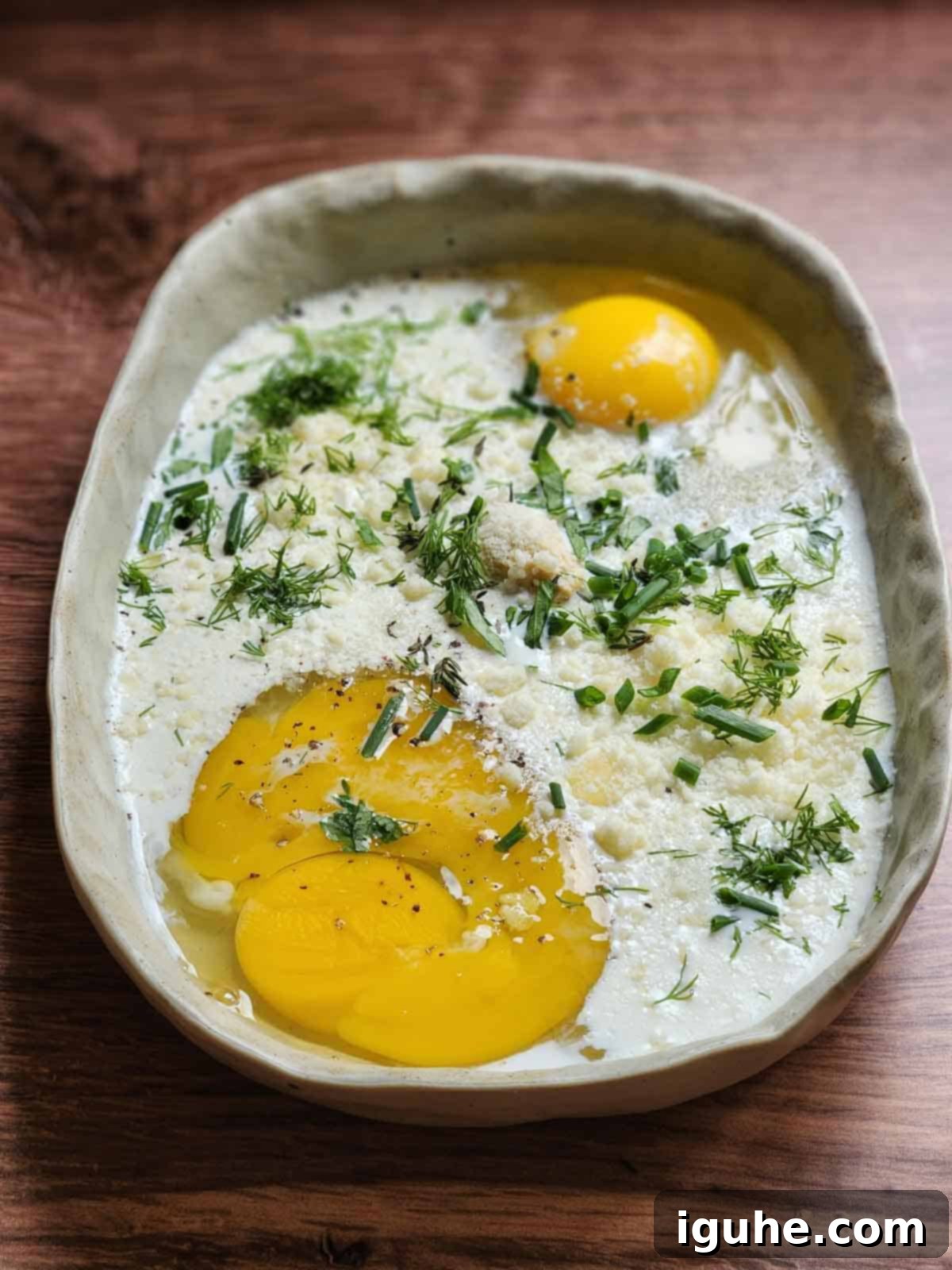
1. Prepare the Custard Base: In a wide, shallow bowl (a pie plate or a baking dish works perfectly), combine all the custard ingredients: eggs, half & half, 4 tablespoons of Parmesan cheese, Dijon mustard, minced garlic, lemon zest, lemon juice, fresh herbs, salt, pepper, and optional horseradish. Using a wide bowl makes dipping the bread much easier.
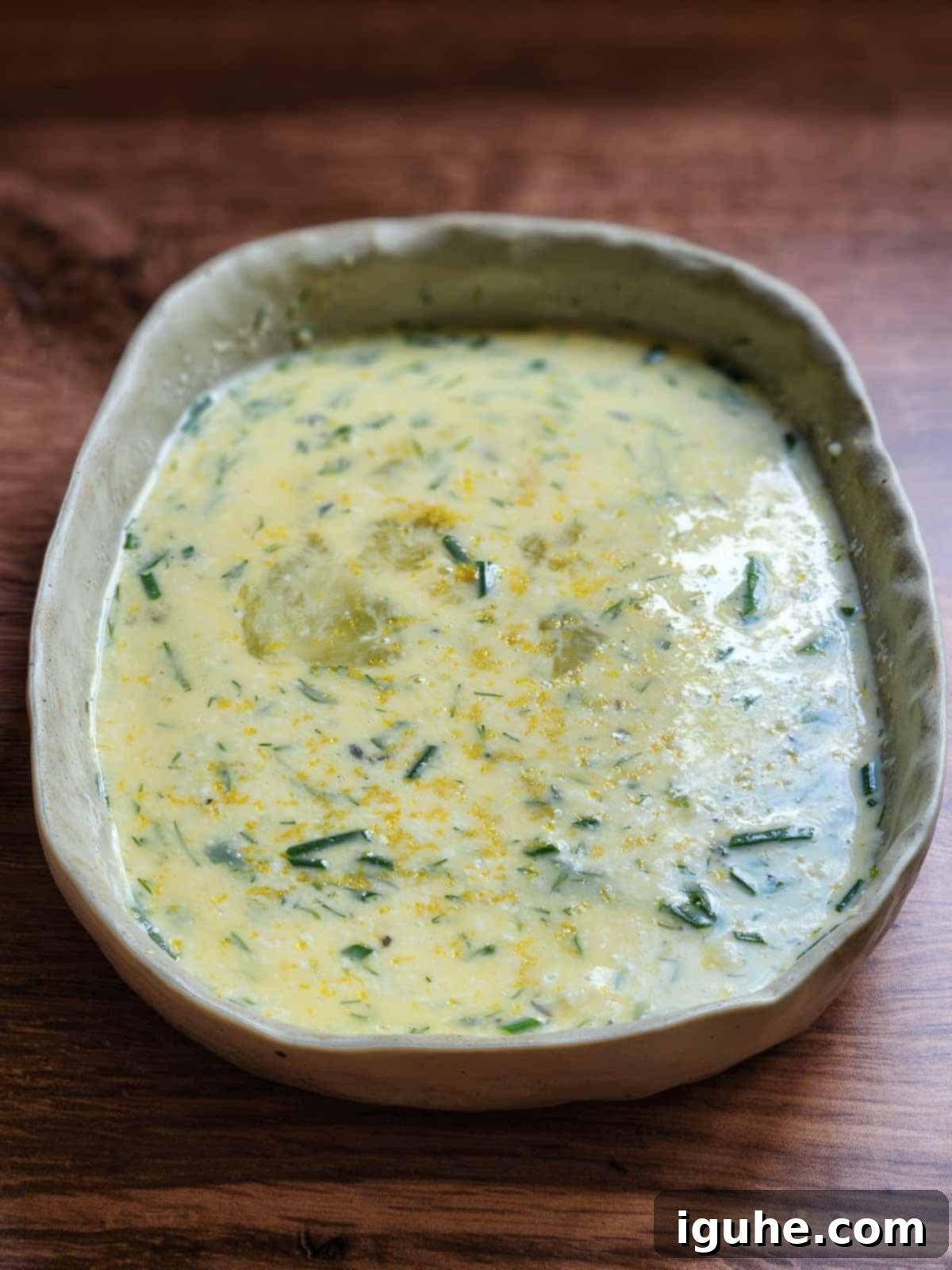
2. Whisk Thoroughly: Using a whisk, thoroughly combine all ingredients in the bowl. Ensure the eggs are fully incorporated, and the herbs, garlic, and zest are evenly distributed throughout the mixture. This is crucial for consistent flavor in every bite.
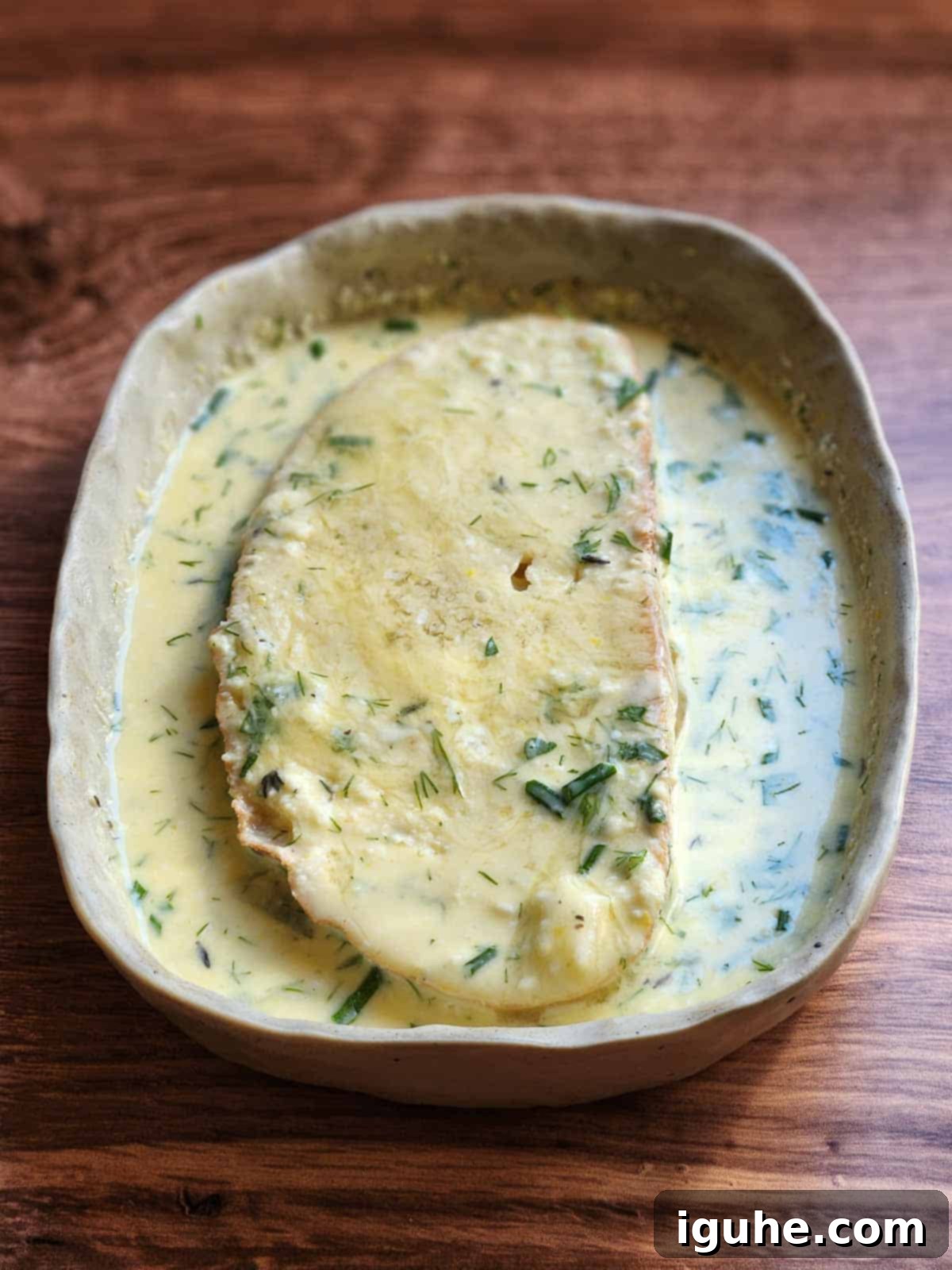
3. Soak the Bread: Place a thick slice of your chosen bread into the custard mixture. Allow it to soak for approximately 20-30 seconds per side. The goal is for the bread to absorb a good amount of the liquid without becoming oversaturated and falling apart. This ensures a creamy interior.
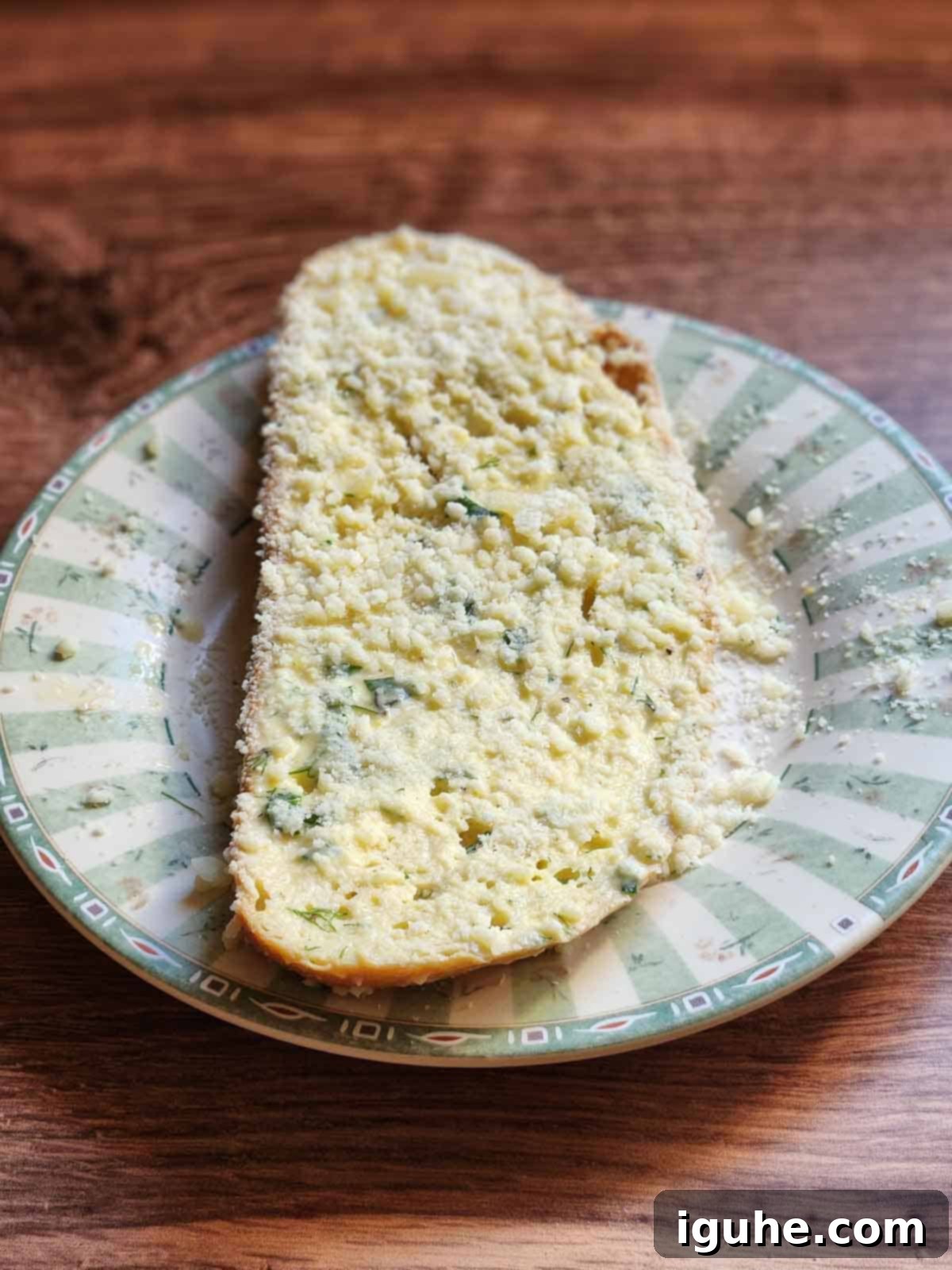
4. Coat with Parmesan: After soaking, gently lift the bread, allowing any excess liquid to drip off for a few seconds. Then, dredge each side of the bread generously in the remaining grated Parmesan cheese. This step creates a fantastic crispy, cheesy crust when cooked.
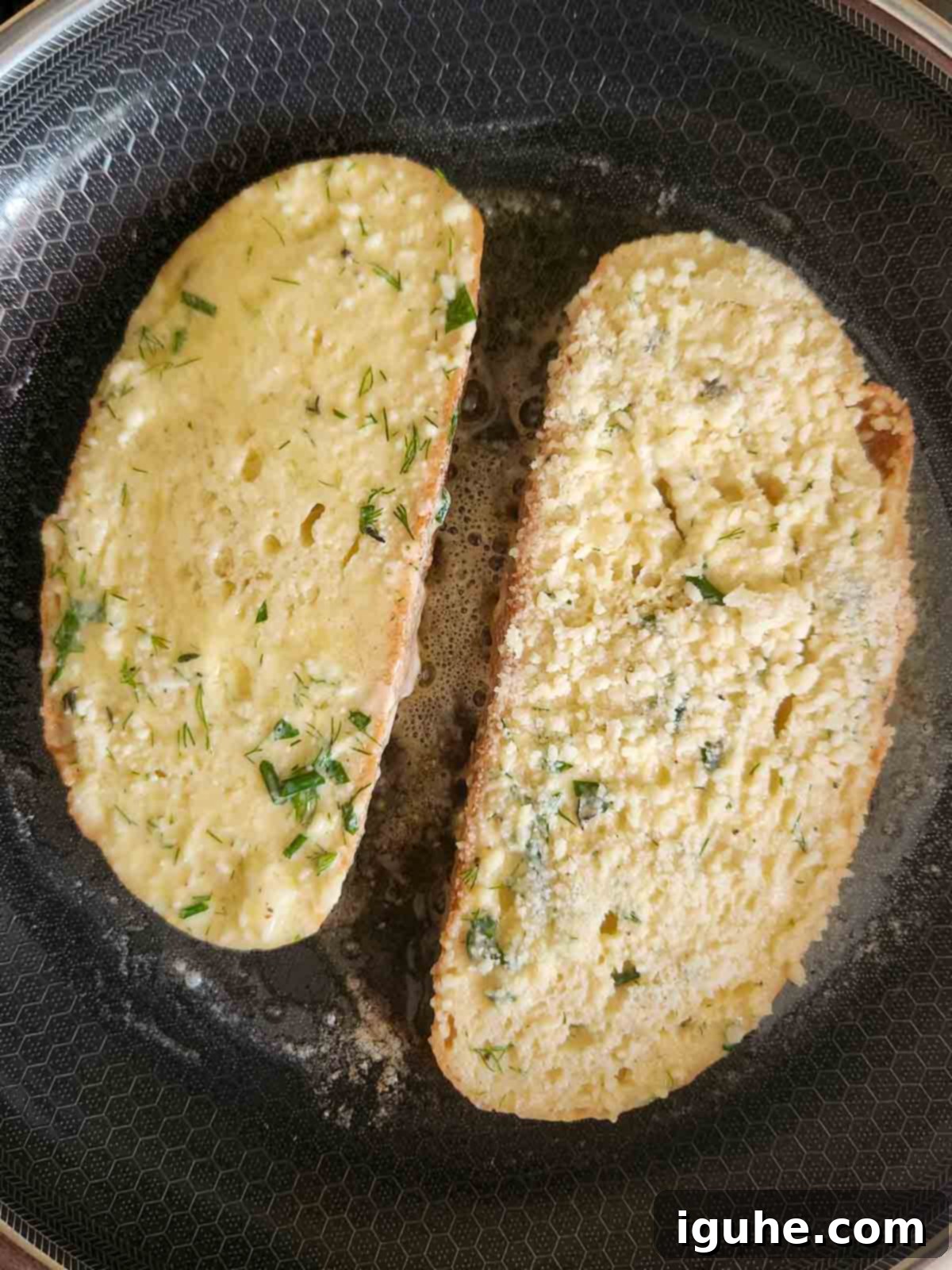
5. Pan-Fry to Golden Perfection: Melt a tablespoon or two of butter in a large non-stick skillet over medium heat. Once the butter is foamy and shimmering, carefully add the coated bread slices. Pan-fry them for about 4 minutes per side, or until they achieve a deep, irresistible golden brown color and a crispy texture.

6. Serve and Enjoy: Once both sides are beautifully browned and crispy, remove the savory French toast from the pan. You may need to add more butter for subsequent batches. Serve immediately with your favorite savory toppings. Don’t let these culinary masterpieces sit – they are best enjoyed hot off the skillet!
👩🍳Expert Tip for the Best Savory French Toast
The secret to perfectly cooked savory French toast lies in two critical steps: when you remove the soaked bread from the egg mixture, let it drip for a few seconds to shed excess liquid. Then, ensure your pan is adequately hot with foamy butter. These steps prevent sogginess and guarantee the custard fully absorbs, giving you that delightful creamy interior combined with perfectly crispy, cheesy edges.
Another pro-tip: Don’t overcrowd the pan. Cook in batches if necessary to maintain consistent heat and ensure each slice browns beautifully without steaming. This yields the best texture for your savory French toast.
Creative Variations for Your Savory French Toast
The beauty of French toast, especially its savory counterpart, is its incredible adaptability. Once you have the core egg-to-milk ratio down, you can truly make this recipe your own. Feel free to adjust the amounts of any ingredients to suit your palate – want more garlic? Go wild! Prefer less salt? Decrease the Parmesan or omit the Kosher salt. It’s all about making it perfect for you.
Here are some exciting ways to experiment with your savory French toast:
- Spice It Up: While fresh herbs are fantastic, don’t shy away from your spice rack! Introduce different savory spice blends. Common pantry spices like a pinch of red pepper flakes for heat, aromatic paprika for a smoky depth, or a touch of earthy cumin can add an unexpected and delightful kick to your custard base. Consider a dash of onion powder for extra umami.
- Cheese Exploration: Parmesan is classic, but why stop there? Experiment with various cheeses to find your next favorite. Gruyère offers a nutty, complex flavor that pairs wonderfully with lemon. Sharp cheddar, crumbled feta, or even a sprinkle of goat cheese can introduce distinct and delicious profiles. For a spicy twist, try Pepper Jack.
- Add More Crunch: If you desire an extra layer of crunch beyond the cheesy crust, try dipping your soaked bread in something different before frying. Panko breadcrumbs will give you a light, airy crispness. For a heartier, rustic texture, try cornmeal or semolina. These coatings create an even more satisfying contrast to the creamy interior.
- Flavor-Infused Bread: Elevate the base of your French toast by choosing pre-flavored bread. Instead of plain sourdough, look for a savory bread such as an olive loaf (with Kalamata or green olives baked in), a fragrant garlic bread, or even a sun-dried tomato foccacia. These will infuse even more complex flavors into every bite, making the dish truly extraordinary.
- Vegetable Power: Incorporate finely chopped spinach, grated zucchini (squeeze out excess water), or finely diced bell peppers into your egg mixture for added nutrients and flavor. Sautéed mushrooms or caramelized onions can also be folded in for a rich, earthy note.

Storage and Prep: Making Ahead & Reheating Your Savory French Toast
While savory French toast is undeniably at its best enjoyed fresh and hot off the pan, smart preparation can help streamline your cooking process and even allow you to enjoy leftovers without sacrificing quality. Here’s how to handle storage and prep:
Preparing the Custard Ahead: The good news is that the egg and herb mixture can be prepared up to 24 hours in advance. Simply whisk all the ingredients together as instructed, then cover the bowl tightly with plastic wrap and store it in the refrigerator. When you’re ready to cook, give the custard a good whisk again to recombine any separated ingredients before dipping your bread. This makes morning brunch prep a breeze!
The Golden Rule for Soaking: The key to avoiding soggy French toast is to wait until just before you’re ready to cook to dip the bread. Soaking the bread too early will cause it to absorb too much liquid, leading to a mushy texture when fried. Follow the recommended soaking time (20-30 seconds per side) immediately before pan-frying.
Storing Leftover Savory French Toast: If you find yourself with a few delightful leftover slices (a rare occurrence, we know!), allow them to cool completely to room temperature. Once cooled, place them in an airtight container and store them in the refrigerator for 2-3 days. This prevents moisture buildup, which can lead to sogginess.
Reheating for Best Results: To bring leftover savory French toast back to life, avoid the microwave, which can make it rubbery and dull. The best method for reheating is to pan-fry the slices in a little butter on the stove over medium heat. This helps restore their crispy exterior and warm, creamy interior. Alternatively, you can reheat them in a toaster oven or conventional oven at around 350°F (175°C) for 5-10 minutes, flipping once, until heated through and crisp.
If you’re making a large batch for a crowd, keep cooked slices warm by placing them on a wire rack set over a baking sheet in an oven heated to a low temperature (around 200°F / 95°C) while you finish cooking the rest.
Serving Suggestions: Beyond the Maple Syrup
With this savory French toast, you won’t miss the maple syrup or powdered sugar one bit! The rich, zesty, and herby flavors stand beautifully on their own, but they also act as a fantastic canvas for a variety of delightful savory toppings. Technically, you can put whatever you want on savory French toast, but we highly recommend trying some of these fantastic (and savory!) ideas to elevate your meal:
- Eggs, Glorious Eggs: A runny yolk is the ultimate creamy contrast to the crispy French toast. Serve it with a perfectly poached egg, a golden-edged fried egg, or even a soft and tender jammy egg. The rich yolk cascades over the toast, adding an unmatched layer of decadence.
- Creamy Avocado: Sliced or mashed avocado provides a cool, creamy counterpoint to the bright lemon and robust herbs. It adds healthy fats and a smooth texture that complements every bite. A sprinkle of flaky sea salt on top of the avocado is a must!
- Elegant Smoked Salmon: For a touch of sophistication and a boost of protein, drape slices of smoked salmon over your French toast. The delicate saltiness and rich flavor of the salmon pair exquisitely with the lemon and dill notes in the toast.
- Hot Honey Drizzle: If you crave a hint of sweet and spicy complexity, a light drizzle of hot honey offers a surprising and addictive contrast. The subtle heat and sweetness enhance the savory profile without taking over.
- High-Quality Olive Oil: Sometimes, simplicity is best. A generous drizzle of good-quality extra-virgin olive oil over the top before serving adds a fruity, peppery note and a luxurious finish.
- Fresh Green Salad: Transform your French toast into a complete meal by pairing it with a light, crisp salad. The freshness and acidity of a simple green salad, perhaps with a vinaigrette, beautifully balances the richness of the toast. Try it with a vibrant shaved asparagus salad with prosciutto or a earthy golden beet salad with tarragon vinaigrette.
- Hearty Soup: For a comforting and satisfying meal, serve your savory French toast alongside a warm bowl of soup. My creamy asparagus leek soup makes an excellent companion, offering a harmonious blend of flavors and textures.
- Crispy Bacon or Prosciutto: For meat lovers, a side of crispy bacon or thinly sliced, pan-fried prosciutto adds an irresistible salty crunch that’s hard to beat.
- Cherry Tomatoes & Balsamic Glaze: Halved cherry tomatoes, quickly sautéed or left raw, add juicy sweetness and acidity. A final drizzle of balsamic glaze ties it all together beautifully.
Jenn’s Signature Serve
Savory French Toast + Fried Egg + Olive Oil
This combination truly highlights the best aspects of the dish – the crispy, herby toast, the rich, runny yolk, and the fragrant, smooth finish of quality olive oil. It’s a simple yet profoundly satisfying way to enjoy your savory French toast.
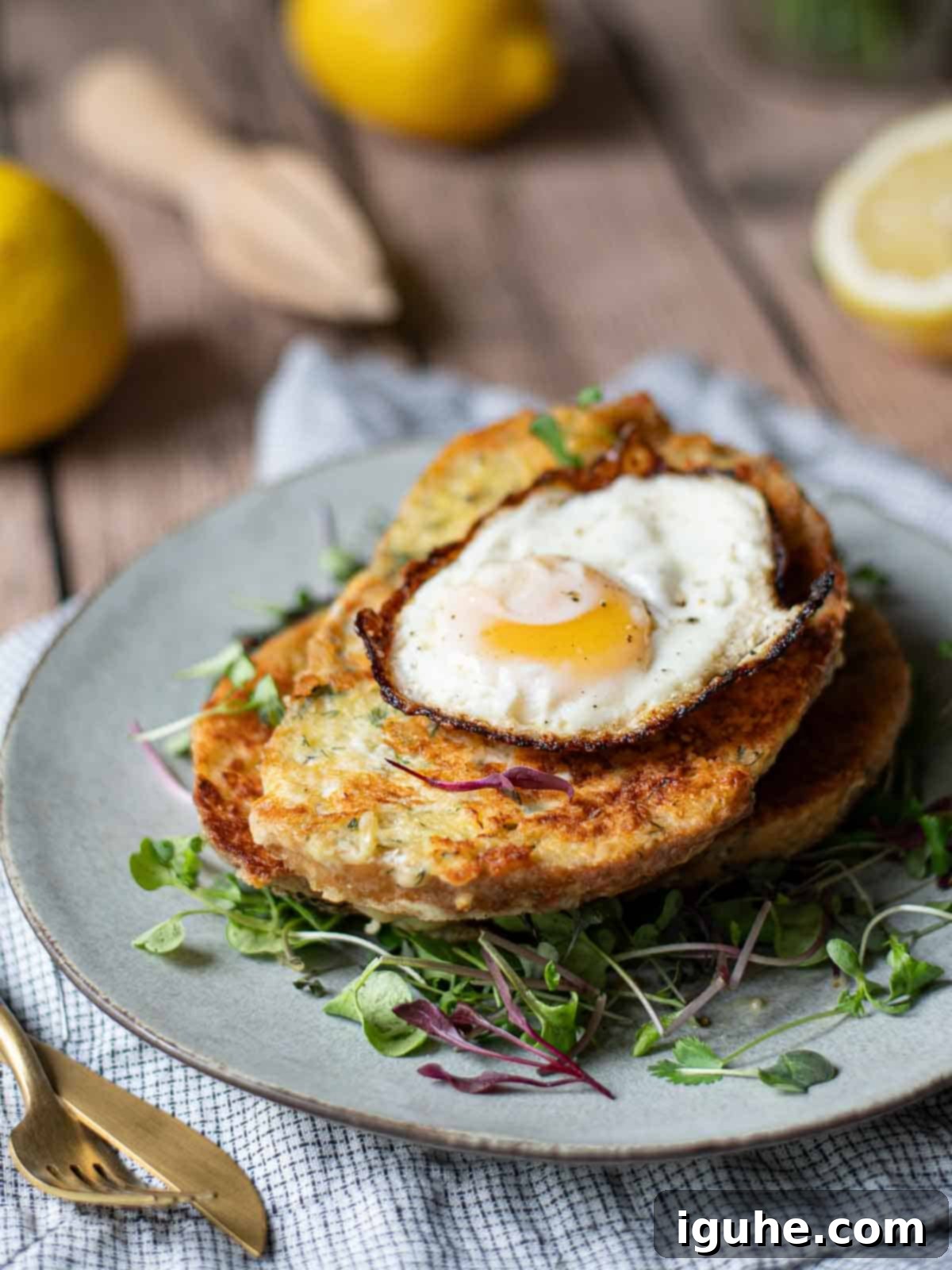
Frequently Asked Questions About Savory French Toast
You can certainly prepare the custard (egg mixture) in advance! Whisk all the ingredients together, cover, and refrigerate for up to 24 hours. However, it’s crucial to wait to dip the bread until just before cooking. Soaking the bread too early will cause it to become overly saturated and soggy when it hits the pan, which we want to avoid for that perfect crispy exterior.
Absolutely! This recipe is quite adaptable for various dietary needs. For a dairy-free version, simply substitute the half & half (or milk) with your favorite unsweetened plant-based milk (almond or oat milk works well) and use a high-quality vegan Parmesan cheese alternative. To make it gluten-free, opt for a sturdy, thick-sliced gluten-free bread. Ensure your chosen substitutes maintain the savory profile and aren’t sweetened.
A large, heavy-bottomed non-stick skillet or cast-iron pan is ideal. Non-stick ensures easy flipping and prevents the cheesy coating from sticking, while a heavy bottom ensures even heat distribution, which is key for achieving that beautiful, consistent golden-brown crust without burning.
Explore More Savory Brunch Ideas
Are you firmly on Team Savory now, or do you still love a sweet treat? If you’re craving more delicious, non-sweet brunch options, here are some of my other favorite savory recipes that are sure to delight your taste buds and shake up your breakfast or brunch routine:
- Miso Deviled Eggs
- Buttermilk Bacon Egg Bites
- Swiss Chard Eggs Florentine with Tomato Hollandaise
- Acorn Squash Egg in a Hole with Hot Honey and Thyme
Did you make this recipe? I would love to hear about it! Please leave a ⭐⭐⭐⭐⭐ rating with a comment right below the recipe card. If you snap a photo of your creation, don’t forget to tag me on Instagram @brunchandbatter.
📖Recipe

Savory French Toast with Parmesan, Lemon & Herbs
Pin Recipe
Equipment
-
large non-stick skillet
-
2 wide shallow bowls or dishes
Ingredients
- 4 large eggs
- ½ cup half & half or milk
- 1½ cups Parmesan cheese, divided (set aside 4 tablespoon for use in the custard)
- 1 teaspoon Dijon mustard
- 1 clove garlic, minced
- 1 tablespoon lemon zest (from about 1 medium lemon)
- 1 tablespoon fresh lemon juice
- 3-4 tablespoon chopped fresh herbs such as dill, parsley, tarragon, thyme, or chives
- ½ teaspoon Kosher salt
- ¼ teaspoon freshly ground black pepper
- 1 teaspoon prepared horseradish, optional for a little kick
- 2-4 tablespoon butter, unsalted (if using salted butter, decrease or omit the salt in the recipe)
- 6-8 slices thick, sturdy bread such as sourdough or ciabatta
Instructions
-
In a wide, shallow bowl, whisk together the eggs, half & half (or milk), 4 tablespoon of the Parmesan, Dijon mustard, garlic, lemon zest, lemon juice, herbs, salt, pepper, and horseradish (if using) until well combined.4 large eggs, ½ cup half & half or milk, 1½ cups Parmesan cheese, divided, 1 teaspoon Dijon mustard, 1 clove garlic, minced, 1 tablespoon lemon zest (from about 1 medium lemon), 1 tablespoon fresh lemon juice, 3-4 tablespoon chopped fresh herbs such as dill, parsley, tarragon, thyme, or chives, ½ teaspoon Kosher salt, ¼ teaspoon freshly ground black pepper, 1 teaspoon prepared horseradish, optional
-
Add the remaining Parmesan to a shallow plate and set it next to the egg mixture.
-
Dip each slice of bread in the egg mixture, allowing it to soak for about 20-30 seconds on each side. Lift the bread out, allowing some of the liquid to roll off, then dredge each slice in the Parmesan cheese, flipping to coat both sides.
-
Melt the butter in a large non-stick skillet over medium heat. When the butter is foamy, add the bread and sear/pan-fry until a deep golden brown, about 4 minutes per side. Remove from the pan, add more butter, and repeat with the remaining bread. Serve immediately.2-4 tablespoon butter, unsalted, 6-8 slices thick, sturdy bread such as sourdough or ciabatta
Notes
- Savory French toast is better with a thick, sturdy bread, like sourdough or ciabatta.
- Use a spatula to peek under the toast to check for doneness. It should be crispy and have a deep, golden brown color.
- Top with a fried egg, olive oil, or a squeeze of lemon. See the post for more serving suggestions.
- If making a large batch, heat the oven to 200°F. Set a wire rack over a baking pan, and transfer the cooked slices to keep warm while you cook the remaining slices.
Nutrition*
*Nutrition information is provided as a courtesy and is an estimate only. Nutrition information can vary depending on many factors, such as products used, measurements and substitutions, therefore it is recommended that you obtain nutritional calculations based on your own finished recipe.
